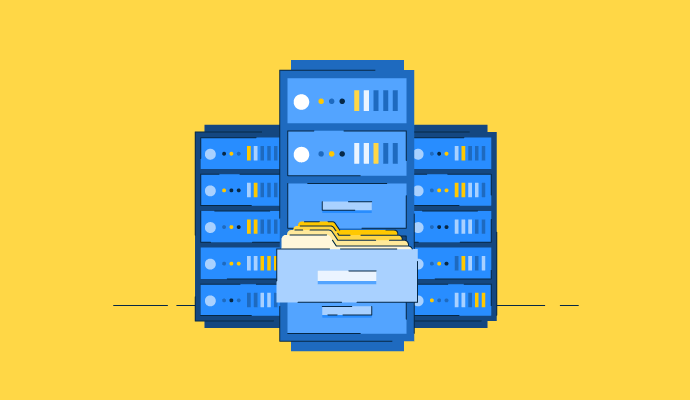March 27, 2025
 by Samudyata Bhat / March 27, 2025
by Samudyata Bhat / March 27, 2025

Filing cabinets are obsolete. So are storage silos and reactive backup plans.
In 2025, data storage isn't just about where information lives; it's about how businesses access, protect, and scale that data in real time. It has become a strategic priority for any business managing large volumes of information.
Whether you're building AI models, running cloud-native apps, or trying to protect mission-critical data from ransomware, the storage system you choose impacts more than performance. It affects costs, compliance, collaboration, and long-term agility.
Data storage refers to the process of saving digital information in physical or cloud-based systems. Devices like hard drives, SSDs, and servers store data using magnetic, electronic, or optical methods. Cloud services offer remote storage, allowing users to access data over the internet.
Users provide input data, but computers need a way to store it beyond just temporary random access memory (RAM). While Read-only memory (ROM) offers permanent storage, it can't be edited.
The challenge was finding a cost-effective, spacious solution that retained data even after shutdowns and allowed for changes to be made. The solution: data storage.
Data-driven businesses, especially, rely heavily on finding dependable and effective solutions for storing their vast amounts of data.
This includes traditional file and block storage and increasingly important object storage solutions for managing massive amounts of unstructured data, such as images, videos, and archives.
To address today's high-level computing demands, such as big data projects, artificial intelligence (AI), machine learning (ML), and the internet of things (IoT), companies and individuals require data storage.
According to G2’s State of Hybrid Cloud Storage Software report, 86% of users saw increased productivity after adopting hybrid cloud storage solutions—highlighting how scalable, cloud-based infrastructure supports modern workloads like AI, ML, and big data.
The flip side of requiring massive data storage is protecting against data loss due to disaster, failure, or fraud. Organizations may also use data storage as a backup option to avoid data loss.
Here are some data storage advantages that highlight the impact of an appropriate solution on an organization:
Data can be collected and stored in three ways – files, blocks, or objects.
* These are the top 5 object storage solutions as per G2’s Spring 2025 Grid® Report.

Users require storage devices to store data in any format. Data storage devices are classified into direct area and network-based storage.
As the name indicates, direct area or direct-attached storage (DAS) is often nearby and directly connected to the computer equipment used. Often, it is the only machine linked to it. DAS can also provide adequate local backup services, although sharing is restricted.
Floppy disks, optical discs or compact discs (CDs), digital video discs (DVDs), hard disk drives (HDD), flash drives, and solid-state drives (SSD) are examples of DAS devices.
Network-based storage enables several computers to access it over a network, making it ideal for data sharing and collaboration. Its capacity to store data off-site makes it ideal for database backups and data security.
Network-attached storage (NAS) and storage area network (SAN) are two typical network-based storage configurations.
NAS is often a single device with a redundant array of independent drives (RAID). SAN storage may be defined as a network of many devices, such as SSD and flash storage, hybrid storage, hybrid cloud storage, backup software and appliances, and cloud data storage.
|
NAS |
SAN |
|
Single storage device |
Multiple device network |
|
File storage system |
Block storage system |
|
TCP/IP ethernet network |
Fibre channel network |
|
Limited users and speed |
Multiple users and faster performance |
|
Limited expansion |
Highly expandable |
|
Low cost with easy setup |
High cost and complex setup |
Numerous data storage systems offer dependable information security. Computer memory and local storage may not be sufficient to preserve private data. Non-volatile data storage is the greatest security option, which does not require constant power to store and retain data.
Flash storage is a solid-state technology that writes and stores data using flash memory chips. A solid-state disk (SSD) flash drive uses flash memory to store data.
Compared to hard disk drives (HDDs), a solid-state system has no moving components and hence reduces latency, requiring fewer SSDs. Because most current SSDs are flash-based, flash storage is synonymous with solid-state storage.
SSDs and flash have faster throughput than HDDs, although all-flash arrays can be costly. Many businesses use a hybrid method that combines flash speed with hard drives' storage capacity.
A well-balanced storage infrastructure enables businesses to choose the appropriate technology for various storage requirements. It provides a cost-effective alternative to moving from regular HDDs to flash drives.
Cloud storage is more cost-effective and scalable than keeping content on-premises on hard drives or storage networks. Cloud service providers help store data and files in a remote place accessible through the public internet or a dedicated private network connection.
The provider hosts, protects, administers, and maintains the servers and related infrastructure, ensuring accessibility whenever needed. This is why businesses looking to improve organizational, operational, and technical capabilities are migrating on-premises workloads and data centers to the cloud.
Tip: Cloud migration software replaces outdated hardware, eliminates expensive upgrades, and puts an end to high-priced data center leases.
Hybrid cloud storage incorporates components of the private and public clouds. Organizations may pick which cloud to store data on using hybrid cloud storage. For example, highly regulated data that requires stringent archiving and replication is generally better suited to a private cloud environment.
Less sensitive data, on the other hand, can be kept on the public cloud. Certain enterprises use hybrid clouds to complement their internal storage networks with public cloud storage.
of the respondents to a G2 survey use hybrid cloud storage software.
Source: G2’s Hybrid Cloud Storage Survey
Backup storage and appliances guard against data loss due to catastrophe, failure, or fraud. They create periodic backups of data and applications to a different, secondary device, which they subsequently employ for disaster recovery.
Backup appliances range from hard disk drives and solid state drives to tape drives and servers, but backup storage may also be provided as a service, often known as backup-as-a-service (BaaS). BaaS, like other as-a-service solutions, offers a low-cost alternative for data protection by storing it in a distant place with scalability.
G2’s research found that 37% of users value faster data recovery during outages, making features like backup restoration speed a key reason companies lean toward hybrid and cloud-based storage options.
Aside from being quicker and more dependable than paper-based storage solutions, digital data storage provides a slew of other advantages.
Many businesses use hybrid infrastructure combining SSDs for performance and HDDs for capacity. But here's a quick breakdown for you:
| Feature | SSD | HDD |
| Speed | Faster read/write | Slower, mechanical |
| Durability | No moving parts | Susceptible to failure |
| Cost | Higher per GB | More affordable |
| Best for | Performance workloads | Bulk storage, archives |
The data storage and data management field is continuously developing. The most recent network storage developments can provide forward-thinking and comprehensive solutions for enterprises that need to store a massive volume of sensitive data.
Some advanced storage alternatives are available for companies that need more complex big data storage.
Traditional data storage necessitates using hardware and proprietary software. When an increased storage capacity is required, businesses scurry for additional hardware.
On the other hand, software-defined storage (SDS) decouples the software layer between where data is physically kept and how it is retrieved. Separating storage software from its hardware helps increase storage capacity on any industry-standard server or x86 system. It eliminates the requirement to purchase more proprietary hardware and employs storage devices from the same manufacturer.
By abstracting the software layer, organizations may place their data anywhere, with the ability to scale up or down as needed. SDS provides additional benefits such as automated management, cost-effectiveness, and connecting several data sources to create a storage infrastructure.
Storage virtualization refers to the accumulation of storage capacity from several physical devices and their subsequent reallocation in a virtualized environment. It is the consolidation of physical storage from several devices into what appears to be a single storage device controlled by a central console.
Using software to locate available storage capacity, the technology aggregates that capacity into a pool of storage that virtual machines may use in a virtual environment.
Storage virtualization, as opposed to SDS, which separates the software layer from the hardware to establish a storage infrastructure, merely pools storage resources to appear to users as a single, normal read or write to a physical drive.
It hides the storage system's complexity, allowing users and administrators to perform operations like backup, archiving, and recovery more efficiently and time efficiently. Storage virtualization can also assist in increasing storage capacity without having to purchase additional storage systems.
The next step up from storage virtualization and SDS is hyper-converged storage (HCS). HCS uses the cloud to integrate computing, virtualization, and storage operations into a physical unit that can be administered as a single system.
This is software-defined storage because each node has a software layer that runs virtualization software identical to all other nodes in the cluster. This program virtualizes and distributes the resources in each node, allowing storage and other resources to be used as a single storage or computation pool.
As per G2, 49.5% of users integrate multiple cloud solutions, with over half managing three or more tools. This trend reflects how enterprises build flexible hybrid ecosystems rather than rely on single-vendor storage stacks.
The future of data storage is moving away from traditional tiered units and toward combination services. These give enterprises greater control over their data and minimize the need for big IT teams, as many activities can be done remotely.
With the evolution of faster computers, our data dependency has increased manifold. However, data loss can occur anytime due to various factors, including ransomware, hardware failure, power outages, natural catastrophes, and human error.
To keep the data center and network running smoothly and without interruptions during regular business hours, businesses must take the time to back up critical data and files. A company's data disaster recovery plan is like insurance - you hope you never have to use it.
Learn more about data disaster recovery and the different solutions involved in it.
This article was originally published in 2024. It has been updated with more data points.
Samudyata Bhat is a Content Marketing Specialist at G2. With a Master's degree in digital marketing, she currently specializes her content around SaaS, hybrid cloud, network management, and IT infrastructure. She aspires to connect with present-day trends through data-driven analysis and experimentation and create effective and meaningful content. In her spare time, she can be found exploring unique cafes and trying different types of coffee.
Cloud storage has made it easier for us to store our data. Previously, you might have used...
 by Sagar Joshi
by Sagar Joshi
It’s a given: buyers are becoming smarter with every purchase.
 by Gowri Ramkumar
by Gowri Ramkumar
Clinical documentation persists as one of the most important aspects of working as a...
 by Katherine Ellison
by Katherine Ellison
Cloud storage has made it easier for us to store our data. Previously, you might have used...
 by Sagar Joshi
by Sagar Joshi
It’s a given: buyers are becoming smarter with every purchase.
 by Gowri Ramkumar
by Gowri Ramkumar


